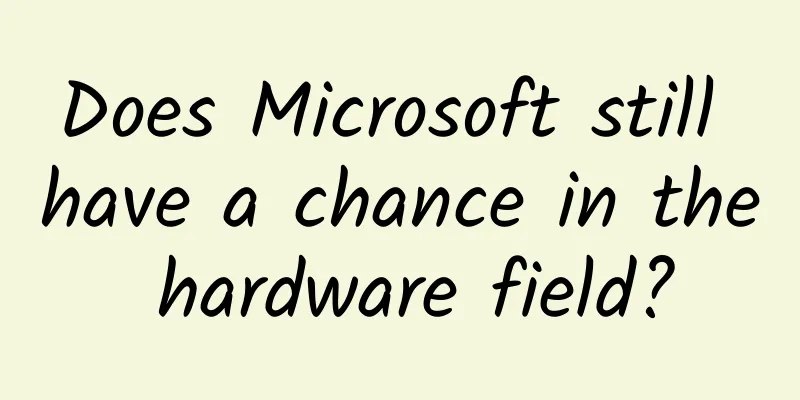Does Microsoft still have a chance in the hardware field?

|
This week, Microsoft released the third generation of Surface tablet computer. The market's first reaction to Surface Pro 3 was good. FBR Capital Markets analyst Daniel Ives said: "This is the best move Microsoft has made in the right direction, and its market share will definitely increase. Microsoft is in a disadvantageous situation now, but we must believe that Nadella can speed up the company's pace in gaining market share." But the facts facing Microsoft are still cruel: in the tablet computer field, Surface, which has been on the market for more than two years, is still losing money and has less than 2% market share. Not only can it not shake the leading position of iPad, it has even been left behind by manufacturers such as Samsung and Lenovo. In the field of smartphones, the WP system that Microsoft has invested heavily in has only 3% market share, and after acquiring Nokia , it has not yet come up with a blockbuster product. Although Microsoft CEO Nadella has formulated a new strategy of "mobile and cloud computing first", he clearly pointed out at the Surface 3 launch conference that the company has not yet succeeded in the field of mobile phones and tablets. Nadella recognizes the reality, but the key question is, does Microsoft still have a chance in the hardware field? Microsoft is struggling in the mobile battlefield "$500, completely subsidized by carriers?! That's the most expensive phone in the world. It won't appeal to corporate customers because it doesn't have a keyboard." This was Ballmer's comment on the iPhone that year. Foreign media believe that perhaps nothing has done more harm to Microsoft's mobile business than Ballmer's short-sightedness. When Apple released the first iPhone, Microsoft's "disdainful" attitude towards it brought bitter consequences. When smartphones gradually became popular, Microsoft had to copy the iPhone's operating system and business model, first launching WP7, then releasing WP8, first strategically cooperating with Nokia, and then acquiring it, but everything was too late. The latest data from market research firm Canalys shows that in the first quarter of 2014, 81% of smartphones ran on the Android system, while iOS and Windows Phone accounted for 16% and 3% respectively; by manufacturer, Samsung accounted for 34.9% of the market share, Apple ranked second with 13.9%, Lenovo ranked third with 7.5%, Huawei, ZTE, LG and others were all on the list, while Nokia was nowhere to be seen. From this we can see that, whether it is operating systems or hardware devices, Microsoft has been completely squeezed out of the first camp, and the gap with the market leaders continues to widen. Like smartphones, the latest data from market research firm IDC shows that in the first quarter of 2014, iPad's market share declined, but it still ranked first with a 32.5% share. Samsung's share increased to 22.3%, and Asus, Lenovo, and Amazon ranked third to fifth. Microsoft Surface is not among the world's top five tablet manufacturers. Michael Walkley, an analyst at Canaccord Genuity, believes that in the mobile device market, Samsung and Apple have already had a clear advantage, and other manufacturers, as competitors, are in a dilemma of being unable to continue competing. This phenomenon is like the famous "Matthew effect", that is, the strong get stronger and the weak get weaker. In terms of devices, Apple and Samsung have formed a duopoly, and in terms of operating systems, Google and Apple have a monopoly. Although many other manufacturers have made efforts, they can only occupy a small share, even giant companies like Microsoft. So, what opportunities are left for Microsoft in the hardware field? Currently, the most influential product of Microsoft in the hardware market may be the Xbox game console. Microsoft, Sony and Nintendo have formed a three-way competition in the game console market, but the scale of the game console market is still dwarfed by devices such as smartphones and tablets. Therefore, it seems that the only area left for Microsoft to imagine is the wearable device field. Many research institutions are optimistic about the market for wearable devices: CNIT-Research believes that the sales volume of wearable devices will exceed 100 million units in 2017; research institution Displaybank estimates that from 2014 to 2016, the sales volume of wearable devices will maintain a growth rate of more than 90%, and by 2020, the market size of wearable devices is expected to reach US$22.7 billion. From this year's CES and MWC, it can be seen that wearable devices have gotten rid of the supporting role of the past two years and gradually become the protagonist of the exhibition. Many manufacturers have displayed wearable devices. Therefore, some analysts believe that if Microsoft wants to regain its prestige in the field of consumer technology, it must focus on the future, and wearable devices are a major opportunity it should seize. Currently, major brands such as Apple, Google, Microsoft, and Samsung are all paying attention to the wearable device market. However, the latest IDC market research report shows that wearable devices, including sports wristbands, will grow significantly in the next four years, but due to the lack of applications, they have not yet entered the golden age. It can be seen that the current wearable device market is in its infancy and there is no clear winner, which is undoubtedly a huge benefit for Microsoft. In this new field, Microsoft does not need to play the role of a chaser to catch up with the leader, because once a product is successful, it will become the leader itself. After all, there is no classic product yet. At Microsoft's latest earnings conference, Nadella said: "When it comes to new opportunities, from wearables to the Internet of Things, we hope Windows can participate in all of this." The exposed patent also shows that Microsoft is developing a smartphone product. From this, it can be seen that Microsoft is fully prepared to welcome wearable devices. In addition, Microsoft now has its own hardware manufacturer, Nokia, and in the future it will have the opportunity to achieve a perfect combination of software and hardware like Apple in the smartphone field. For Microsoft, its strong financial resources are its advantage, and it can invest large amounts of money in the research and development of wearable devices. Perhaps this initial investment may be as high as billions of dollars, but once successful, the fruits of victory will bring greater benefits to Microsoft. As a winner of Toutiao's Qingyun Plan and Baijiahao's Bai+ Plan, the 2019 Baidu Digital Author of the Year, the Baijiahao's Most Popular Author in the Technology Field, the 2019 Sogou Technology and Culture Author, and the 2021 Baijiahao Quarterly Influential Creator, he has won many awards, including the 2013 Sohu Best Industry Media Person, the 2015 China New Media Entrepreneurship Competition Beijing Third Place, the 2015 Guangmang Experience Award, the 2015 China New Media Entrepreneurship Competition Finals Third Place, and the 2018 Baidu Dynamic Annual Powerful Celebrity. |
<<: LeEco and Evergrande: Two Ecosystem Benchmarks in China
Recommend
Is it harder to buy than iPhone 6? Huawei Mate7 Standard Edition Review
Unlike the Honor series of mobile phones, which a...
Android process management: How to terminate the process during development
In Android, directly killing the application proc...
Wedding Photography Tencent Advertising Promotion Plan
1. Industry dynamics summary Industry Development...
What is the difference between unemployment insurance and unemployment benefits? Can they be received at the same time?
Friends who participate in social security during...
Check out 8 basic Facebook advertising tips!
For marketers and businesses, advertising on Face...
Because it trapped countless ships, the waters where it "roamed" were called the "Sea of Magic Algae"
Sargassum is a large floating algae belonging to ...
Luliang Mini Program Franchise Company, how much does it cost to join a fresh fruit and vegetable delivery mini program?
Mini programs are now very popular in various ind...
The "dark mode" you see in iOS 13 is actually not eye protection
The bright white background is gradually being re...
New Marketing, New Value——2021 Changan Automobile Technology Ecosystem Conference Marketing Service Forum was successfully held
On the morning of August 27, the 2021 Changan Aut...
Analysis of the regularity of Douyin's popular cases: "Your Little Sweetie" is now worth 500,000
There are many cases of people becoming famous ov...
The public welfare action that started as a director has achieved extraordinary results. NetQin Youth Summer Camp 2017
In our childhood memories, in addition to the bur...
User operation and promotion of full network marketing
In the past, when companies were doing product ma...
How to motivate users to continuously produce high-quality content
Zhihu original question: In addition to the more ...
Black technology in future agriculture: How can green and intelligent fertilizers ensure that crops are well fed without waste?
Imagine that you are a farmer, carrying bags of f...
Four channels and strategies for traffic acquisition
In the Internet age, whether it is e-commerce or ...


![[App Promotion Case] Didi Taxi: 4 Amazing Secrets Behind the Sky-High Subsidies](/upload/images/67cc1cd9b7574.webp)






![[Smart Farmers] A "iron watermelon" grows on a gourd tree! How powerful is this "all-rounder" in the plant world?](/upload/images/67f2131b2d9c9.webp)